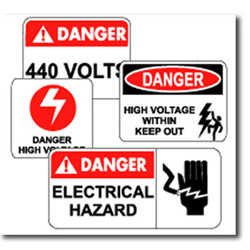
The electrical current in an ordinary home or business has enough power to cause death by electrocution. People don't realize that even the changing of a light bulb without first unplugging the lamp or lighting fixture could be hazardous because the "hot" or live part could injure a person if they contact it.
Any electrical system has the potential to injure. Electricity can be either "static" or "dynamic":
General electrical safety is very important for home owners. It is recommended that all homeowners have their electrical systems inspectded periodically in order to learn of any underlying conditions that may be harmful to their families.
Electrical fires that sometimes occur in the home create personal injuries like burns and loss of personal property and most of these electrical fires are caused by faulty electrical wiring. The two typical types of electrical accidents connected with faulty electrical wiring are mostly caused by: (1) electric shocks and 2) fires. These electric shocks are generally rare but they do occur and a lot of the accidents have been associated with people who have been working on either repairing or modifying electrical equipment. Most accidents seem due to incompetence by the person that is carrying out the electrical work, without any respect for general electrical safety.
Common sense should be applied. The circuit should be isolated through a general electrical safety lockout tagout procedure before any repairs are carried out on the electrical equipment. Another test of the energized circuit should be conducted using a proper electrical test meter to determine if the circuit has been fully isolated. These basic general electrical safety measures could prevent any individual from receiving an electric shock, which depending on the conditions could be fatal.
Understanding Electricity
Electricity forms a "path" or "loop". When you plug in a device, the electricity takes the easiest path from the plug to the tool, and then back to the power source (plug). This creates or completes an electrical circuit. People are injured when they become part of the electrical circuit. Humans are more conductive than the earth, which means if there is no other easy path, electricity will try to flow through our bodies.
There are four chief kinds of general electrical safety injuries:
These injuries can happen in various ways:
General Electrical Safety Practices
It is the employer’s responsibility to inspect on a regular basis all electrical equipment, fittings and installations. This inspection should always be carried out by a person possessing sufficient technical knowledge, experience and skills.
A general electrical safety risk assessment should be undertaken by the employer where there is the potential for harm to be caused and measures to control risks should be implemented.
An inventory of all electrical equipment, fittings and installations on the site should be drawn up. This should record the serial number or another form of identification.
A general electrical safety inspection should take place at least at the following intervals (and more frequently in areas of high usage or subject to abuse):